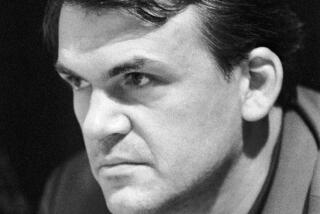‘Concerning E.M. Forster’ by Frank Kermode
- Share via
Concerning E.M. Forster
Frank Kermode
Farrar, Straus & Giroux: 192 pp., $24
E.M. Forster’s “Aspects of the Novel” is required reading for students of the genre. Originally delivered in 1927 as the Clark Lectures at Trinity College in Cambridge, the chapters address such matters as “The Story,” “The Plot,” “People,” “Fantasy,” “Prophecy” and “Pattern and Rhythm,” and they do so in an offhand, quasi-conversational way that wears its learning lightly; few books about the craft of fiction have had so long a shelf-life, or influenced so many. Now Frank Kermode, an influential gentleman of letters, has delivered the Clark lectures -- 80 years later, in 2007 -- on the subject of Forster. This is a somewhat specialized endeavor and one that requires interest in and knowledge of the author -- but in its minor way it, too, is a major achievement: judicious, elegant and wise.
The first three chapters (“Aspects of Aspects,” “Beethoven, Wagner, Vinteuil” and “Krishna”) deal respectively with Forster’s range of cultural interests, his devotion to music and the concern with Eastern culture that informs “A Passage to India,” the novel Kermode considers to be his subject’s best. The second section of “Concerning E.M. Forster,” “A causerie,” is a freewheeling discourse on what the writer did and didn’t do, his place in the world of letters, his private behavior and long public life. Here is the critic’s apt summary:
“Between 1905, when he was twenty-six, and 1910, Forster’s first four novels were published: ‘Where Angels Fear to Tread’ (the first to appear, although not the first to be written), ‘The Longest Journey,’ ‘A Room with a View’ and ‘Howards End.’ So he could look back from the eminence of just over thirty and congratulate himself on an auspicious start. He published his last novel, ‘A Passage to India,’ in 1924, when he was forty-five, and his reflections on fiction in ‘Aspects of the Novel’ three years later. After that he lived on for forty-three years without publishing another novel, although he wrote an enormous amount of nonfiction -- biographies, newspaper articles, lectures, broadcasts, journals, letters by the thousand, and a handful of homosexual short stories (published after his death). Leaving aside the posthumously published and inferior ‘Maurice,’ one thinks of Forster primarily as the author of those five novels, a writer who began with confident originality, reached his apogee in 1924, and then stopped, much concerned about his loss of creativity but unable to recover it.”
Kermode is excellent on Forster’s sensitivity to music, irascible on his lack of interest in experimental fiction or the work of such gifted compatriots as Ford Madox Ford. He describes the intellectual life of Cambridge, the social and epistolary circles Forster cultivated. He raises -- but fails to answer -- the crucial question of the writer’s decline and “loss of creativity,” suggesting it may well derive from a kind of self-imposed silence on the subject of gay sex. There have been important biographies of Forster before (most notably P.N. Furbank’s “E.M. Forster: A Life” in 1977), and there’s little here that’s new. But always Kermode honors the epigraph of “Howards End” and, in “Concerning E. M. Forster,” follows that author’s injunction to “Only connect.”
Delbanco is the Robert Frost distinguished university professor of English language and literature at the University of Michigan. He is the author, most recently, of the novel “The Count of Concord.”
More to Read
Sign up for our Book Club newsletter
Get the latest news, events and more from the Los Angeles Times Book Club, and help us get L.A. reading and talking.
You may occasionally receive promotional content from the Los Angeles Times.







